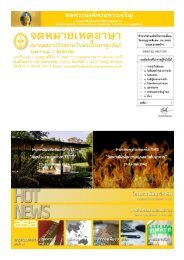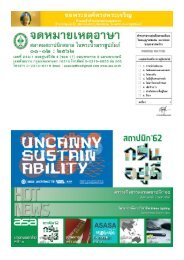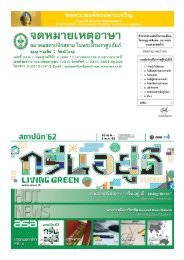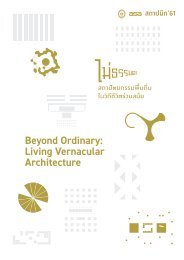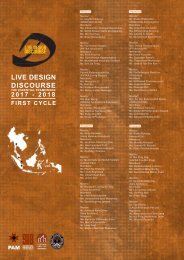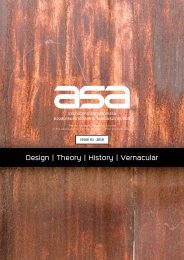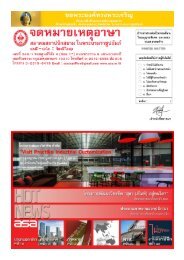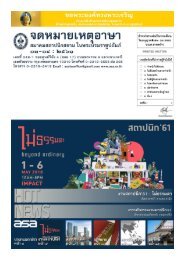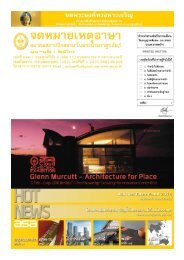ASA JOURNAL Vol.2 | 2018
Create successful ePaper yourself
Turn your PDF publications into a flip-book with our unique Google optimized e-Paper software.
All the prerequisites for every man-made object should<br />
same as the rhetoric of modernist architecture elsewhere?<br />
architectural forms generated by the structural principle, but<br />
Both Semper and Bötticher placed a higher value on<br />
lie in its material, purpose and construction, its form<br />
A quick sketch of the 19th-century attitudes towards materials<br />
they also need to be in accordance with the nature of the<br />
artistic symbolism. Unlike Viollet-le-Duc who regarded the<br />
should be consequent upon these prerequisites and not<br />
in the following discussion will give an idea just how differing<br />
materials used to make them. It is this proposition of French<br />
imitation of a form used in one material to another as ‘un-<br />
upon an independent preconceived idea. But above all,<br />
ideas about materials have been.<br />
Rationalists that each material brings out its own ‘truthful’<br />
truthful’ to the nature of the materials, Semper argued that<br />
workmanship should be as sound as possible; this<br />
became the indispensable condition […].(2007, Vol. 1: 148)<br />
After Muthesius returned to Germany, he was the one<br />
who drove German architectural discussion forward by<br />
turning to practical issues of craftsmanship, construction, and<br />
‘Let brick to be brick, stone to be<br />
stone, every material speaks in its<br />
own language’: French Rationalist<br />
In France, Rationalists held that architecture derives from a<br />
form that helped to formulate one of the most well-known<br />
axioms of modernist architects that new material would lead<br />
to a new form of architecture.<br />
‘To forget the material’: Gottfried Semper<br />
and a process of symbolisation<br />
the development of architecture derived from this very process<br />
of metaphorical transformation; only as the nature of the<br />
materials is ‘translated’ can symbolic meaning emerge. Just as<br />
the meaning of the word spoken in one language can be translated<br />
into another language, so too a particular symbolic<br />
meaning in architecture is transferable between different<br />
materials that he found integral to British arts and crafts<br />
architecture.<br />
However, this is not to say that Modernism was originated<br />
in Britain (as Nikolaus Pevsner does in Pioneers of<br />
Modern Design: From William Morris to Walter Gropius).<br />
Though his association between the Arts and Crafts Movement<br />
and the development of modernism is in certain respects still<br />
valid, recent studies have given a much more comprehensive<br />
view of the origins and development of modernism.<br />
What is more intriguing is about the material – for if<br />
it is so indispensable to architecture, we should ask how it<br />
became an issue in architectural discourse, historically. Since<br />
the mid-1980s onwards, the question about material has<br />
returned to an architectural discussion so frequently that in<br />
any talk on architecture or any building visit, it is almost<br />
impossible not to hear somebody talk about ‘material’ or<br />
‘materiality’. Our possible discussions about architecture<br />
concerning material today such as ‘the true nature of the<br />
material’, ‘the truthful expression of the material’ or ‘to put the<br />
materials into limits’ as well as using the term like ‘dematerialisation’,<br />
might lead one to take it for granted that they are a<br />
part of an architect’s innate abilities, although this is far from<br />
accurate.<br />
The definition of architecture as an art of material was<br />
a 19th-century creation. Although architects used materials<br />
to make buildings for centuries, before the 19th century it did<br />
not occur to any architect to describe their work in terms of<br />
materials. The opportunity is taken here to look historically<br />
at its basis and at the way in which it had been discussed in<br />
relation to architecture. What then, we may ask, does it means<br />
to say that architecture is the art of materials? Can we see the<br />
determined system of structure. Viollet-le-Duc (1814-1879,<br />
fig 2) proposed that ‘all architecture proceeds from structure,<br />
and the first condition at which it should aim is to make the<br />
outward form accord with that structure’. (1959:3) In other<br />
words, what is built takes second place to the system that was<br />
adopted to build it. Structure, for Viollet, is irreducible, permanent,<br />
surpassing beyond the life of the building itself; though<br />
buildings decay, their structures endure, and it is possible to adopt<br />
a structural system of old buildings. An example of this is the<br />
system of vaulting of the thirteenth-century Gothic cathedrals<br />
for a creation of new architecture. (fig 3)<br />
Such a manner of reworking something old and translating<br />
into a new form does not, according to Rationalist<br />
principle, apply to materials. Viollet-le-Duc proposed that the<br />
form of architecture, apart from being the outcome of the<br />
structure, needs to communicate the characteristic of the<br />
material of which it is made of. Viollet-le-Duc made this point<br />
clear when he put it as follows:<br />
Does it then follow that if we would make use of the<br />
novel materials […], we should content ourselves with<br />
substituting arches of cast or plate iron for arches of<br />
stone? No, we may adopt the principle, but while adopting<br />
it, since the material is changed, we should change the<br />
form. (1959: 54)<br />
Viollet-le-Duc’s question was in opposition to the then<br />
current convention when a reproduction of the past styles was<br />
common. What Viollet was against here is the mimicry of a<br />
form used in one material for another material. Criticising<br />
Auguste Boileau’s church (fig 4), whose form is that of Gothic,<br />
but made out of cast iron, Viollet said ‘one should not give to<br />
cast iron the appearance of stone, for any change of<br />
The second distinctive idea of materials that contributed to<br />
modernist discourse belongs to the building culture of the<br />
nineteenth-century German-speaking countries. In his theory<br />
of style, Gottfried Semper (1803-1879, fig 5) proposed that the<br />
ultimate goal of architecture is to bring out symbolism. While<br />
this impulse for the symbolic is to be realised in the actual<br />
physicality of the work, Semper, however, argued that it is<br />
crucial to forget about the properties natural to the materials<br />
in order to reach a level of symbolic creation. ‘The destruction<br />
of reality, of the material’, Semper said, ‘is necessary if a form<br />
is to emerge as a meaningful symbol, as an autonomous human<br />
creation’. (2004: 439) A little further he continued:<br />
Only complete technical perfection, only the judicious<br />
and proper treatment of the material according to its<br />
properties, and above all only the consideration of these<br />
properties in the act of shaping form can cause the<br />
material to be forgotten, can liberate the artistic creation<br />
from it, can elevate even a simple landscape painting<br />
to become a high work of art. […] the appear of a work<br />
of art should make us forget the means and the materials<br />
by which and through which it appears and works<br />
and be sufficient to itself as form – to demonstrate this<br />
is the most difficult task of a theory of style. (2004, 439)<br />
Semper’s rejection of the physical properties of materials<br />
is perhaps best illustrated by another German theorist, Carl<br />
Bötticher, when he gave an example of stone:<br />
the intention here is not to characterize the stone as dead<br />
stone but, on the contrary, to let the dead substance of<br />
the stone fade away […] As soon as the stone is covered by<br />
a form analogous to its idea (i.e., an art-form), the concept<br />
of the stone has disappeared and that of the analogue<br />
media. (fig 6)<br />
‘Bring forth the materials’: Ruskin and<br />
Heidegger<br />
The next architectural idea of materials, we now consider, was<br />
proposed by the nineteenth-century British architectural<br />
thinker John Ruskin (1819-1900, fig 7). In The Seven Lamps<br />
of Architecture, Ruskin’s view of materials was that the material<br />
on its own was not active in the creation of architecture. While<br />
Ruskin would have agreed that different materials possess<br />
different physical properties and that no material is quite the<br />
same as another, for him, what was lacking in raw materials<br />
were intellectual thought and human labour. For Ruskin, only<br />
by these extrinsic elements employed in the fabrication process<br />
can unanimated materials be rendered into a sophisticated,<br />
lively object of architecture, and it is in this capacity of turning<br />
‘inert substance’ into a ‘life’ that set architecture apart from<br />
other forms of production. In The Lamp of Life, Ruskin put his<br />
idea as follows:<br />
this is especially true of all objects which bear upon<br />
them the impress of the highest order of creative life,<br />
that is to say, of the mind man: they become noble or<br />
ignoble in proportion to the amount of the energy of<br />
that mind which has visibly been employed upon them.<br />
But most peculiarly and imperatively does the rule hold<br />
with respect to the creations of Architecture, which<br />
being properly capable of no other life than this, and<br />
being not especially composed of things pleasant in<br />
themselves, – as music of sweet sounds, or painting of<br />
fair colors, but of inert substance, – depend, for their<br />
dignity and pleasurableness in the utmost degree, upon<br />
the vivid expression of the intellectual life which has<br />
been concerned in their production. (1865: 123)<br />
concern with materials as having a theoretical context specific<br />
materials must bring about a change of forms.’ (Viollet-le-Duc,<br />
takes its place. (as quoted in Herrmann, 1984: 143)<br />
to a particular place, in a particular time, or was it just the<br />
1885; as quoted in Legault, 1997: 25) For Viollet, not only are<br />
74 75<br />
วารสารสถาปัตยกรรมของสมาคมสถาปนิกสยาม<br />
ในพระบรมราชูปถัมภ์ Issue 02 / <strong>2018</strong><br />
Academic Journal of The Association of Siamese Architects<br />
under the Royal Patronage<br />
วารสารสถาปัตยกรรมของสมาคมสถาปนิกสยาม<br />
ในพระบรมราชูปถัมภ์ Issue 02 / <strong>2018</strong><br />
Academic Journal of The Association of Siamese Architects<br />
under the Royal Patronage




